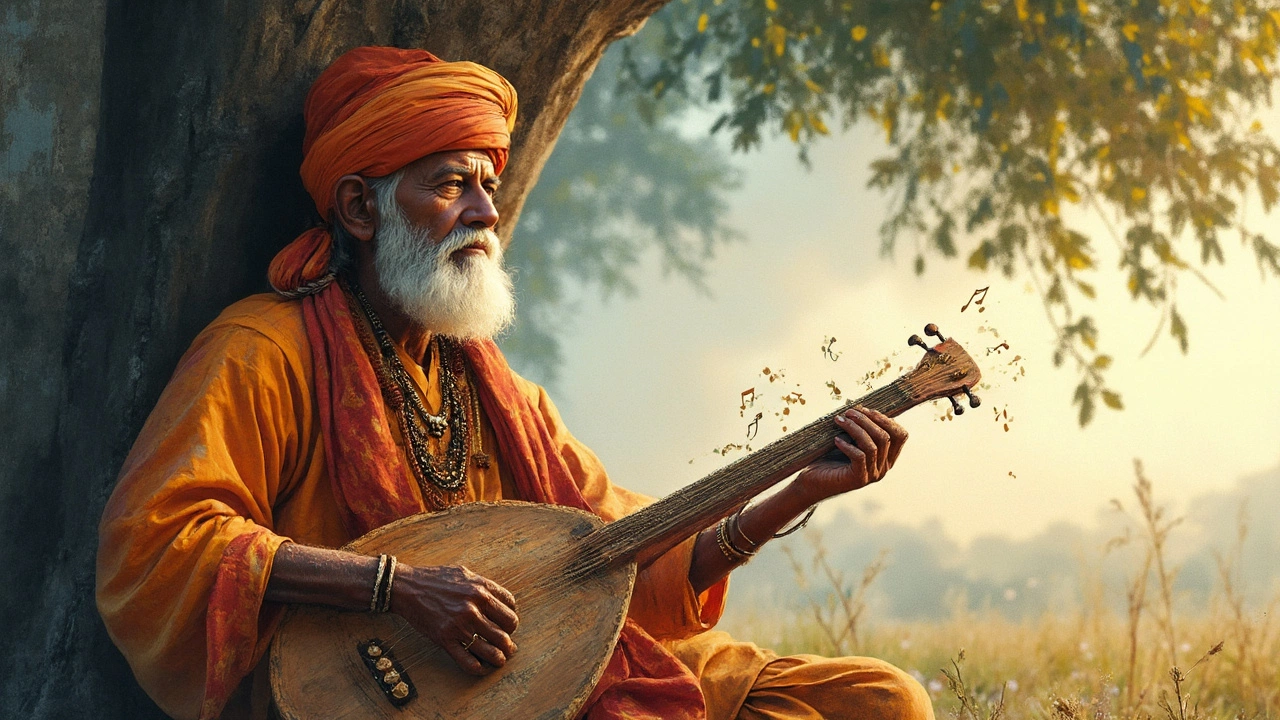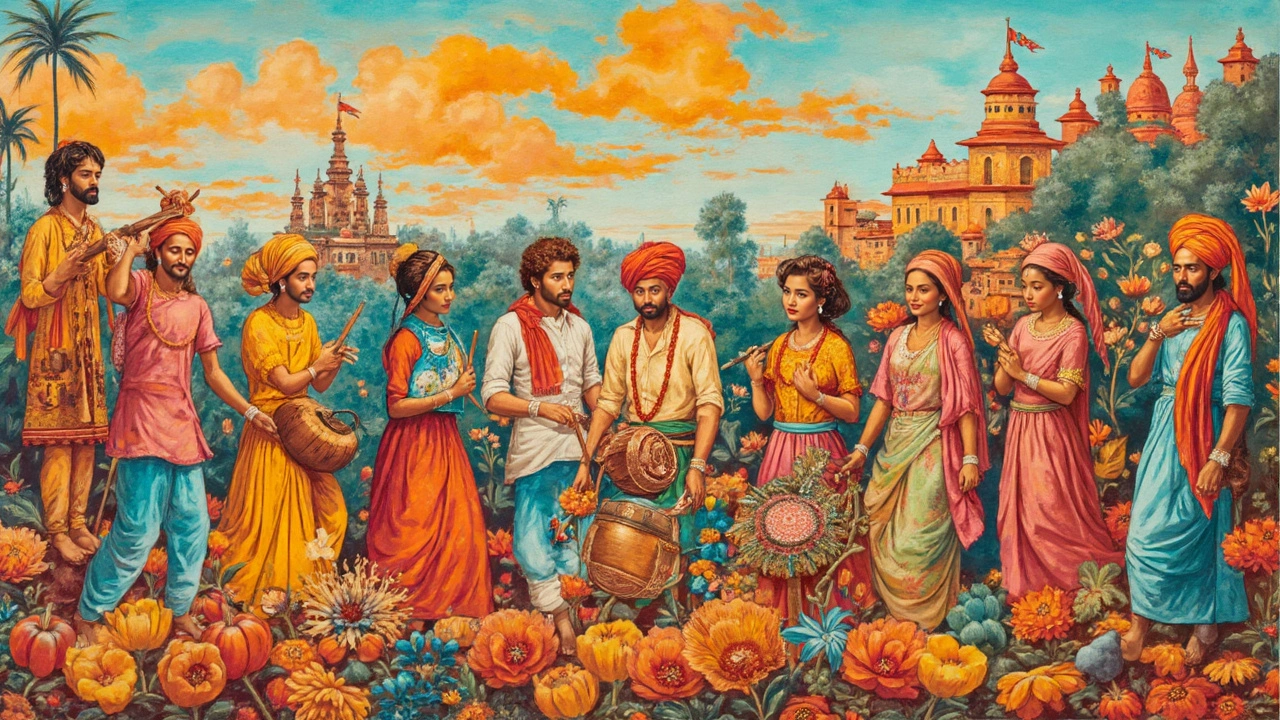Ask someone in India to sing a folk song and you’ll probably get something different depending on where you are. Folk songs aren’t chosen from a playlist—they’re passed down through families and neighbors, sometimes for hundreds of years. The words and tunes often change depending on who’s singing them, but that’s actually the fun of it. Folk songs aren’t about perfection; they’re about sharing stories, feelings, and traditions in a way that makes sense for real people.
If you’ve ever wondered what makes a song “folk,” here’s the deal: it’s usually anonymous, meaning no one can tell you for sure who wrote it. These songs come straight from lived experience—work, weddings, festivals, heartbreaks, and even just long days in the fields. This means each region in India has its own flavor. A Bihu song from Assam feels totally different from a Lavani from Maharashtra, and both sound nothing like Rajasthan’s Maand tunes.
The best part? You don’t need a big stage or a fancy music system to sing a folk song. All you really need is a group of people and maybe a simple instrument—think dholak, flute, or just some clapping. If you want to feel the heart of Indian music, starting with folk songs is never a bad idea.
- Unpacking Traditional Folk Songs
- Indian Folk Songs: Not Your Average Bollywood Tune
- Famous Folk Styles Across India
- How Folks Songs Are Passed Down
- How to Listen, Learn, and Keep Folk Songs Alive
Unpacking Traditional Folk Songs
When people think about “traditional folk song,” they often picture a simple melody sung by regular folks, not pop stars. But there’s a lot more to it. At its core, a folk song is created and carried forward by a community—nobody writes it for fame or money. It’s an honest way to share history, values, and local culture, especially in a diverse place like India.
What sets folk music apart? For starters, these songs aren’t usually written down. They’re learned by listening and repeating, which is why no two versions are exactly the same. You get these little changes as the song moves from one generation to another, and even from one village to the next.
"Folk songs are the living voice of a culture, changing just enough to stay alive through changing times." — Indian Council for Cultural Relations
You’ll notice a bunch of practical things about Indian folk music:
- Lyrics talk about everyday stuff—love, farming, seasons, or hard days at work.
- They use local languages and dialects, sometimes mixing words you won’t find in any big-city textbook.
- Simple instruments tag along, like the ektara or dholak.
- Community matters more than accuracy. Anyone can join in.
Here’s a fun fact: Indian folk songs aren’t all old news. According to a 2023 cultural survey, folk songs are still performed in over 70% of Indian villages during festivals, harvests, and weddings. The tunes echo across fields, courtyards, and market squares—not just at fancy concerts.
This mix of storytelling, music, and local flavor is what keeps folk songs fresh even now. If you want to feel the pulse of any Indian region, look to its folk music before anything else.
Indian Folk Songs: Not Your Average Bollywood Tune
It’s easy to mix up Indian folk songs with the stuff you hear in Bollywood movies, but they’re worlds apart. Bollywood tracks are usually written by professional songwriters and polished until they sound perfect. But folk songs? They come from real life, not a recording studio. They’re like the people’s playlist—most of them existed before Bollywood even started making movies.
Think about this: folk music in India is all about tradition, not trend. When you hear a Punjabi bhangra at a village festival, someone’s probably been singing a version of it for a hundred years or more. No copyrighted lyrics, no official music videos, and the singers are rarely famous outside their own circle. Folk songs have a local flavor, filled with the stories and moods of the place where they were born. Bollywood might have catchy beats, but it almost always borrows ideas from these age-old tunes.
Here’s a quick look at how folk music and Bollywood music stack up:
| Folk Song | Bollywood Song | |
|---|---|---|
| Origin | Passed down through generations | Composed for movies |
| Language | Local dialects/languages | Mainstream Hindi or mixed |
| Performers | Everyday people | Professional singers |
| Themes | Daily life, culture, tradition | Love, drama, entertainment |
| Instrumentation | Simple, often acoustic | Produced, electronic, large arrangements |
There’s another cool thing: Indian folk songs actually change from place to place, and sometimes even from person to person. If you listen to a Rajasthani ‘Ghoomar’ in Udaipur and then catch it at a family wedding in Jaipur, you’ll spot little differences—new verses, different speed, even a different mood depending on the event. Bollywood songs, meanwhile, are the same every time you play them.
Want to experience this yourself? Hit up a local fair, a village festival, or even just a family gathering in rural India. Odds are, you’ll hear a traditional folk song sung live, no mics needed. That’s the magic—real voices, real stories, and a sound that’s always shaped by where you live and who you’re with.

Famous Folk Styles Across India
India’s folk music scene is wild—every state brings its own vibe. It’s not just about different languages or instruments; the actual rhythms and ways people sing or dance can feel worlds apart.
Let’s take a look at some stand-out styles:
- Bihu (Assam): This is the heartbeat of Assam, especially during the spring harvest festival. Bihu songs are fast, fun, and usually full of flirting and playful teasing. You’ll hear lots of dhol, pepa, and taal (cymbals).
- Lavani (Maharashtra): Lavani’s all about catchy beats and bold lyrics. Traditionally, it's performed by women who sing and dance, and the dholki drum really drives the energy.
- Baul (West Bengal): Baul singers are as much spiritual guides as they are musicians. Their songs talk about life, soul, and love, all while playing the ektara (a simple one-stringed instrument).
- Rajasthani Maand: If you’ve ever heard a haunting tune in a movie set in the desert, it’s probably Maand. These songs are classy but folk, talking about love and heroic stories. The sarangi and dholak are big here.
- Bhavageethe (Karnataka): These are emotion-packed songs—less for dancing, more for thinking or feeling. They often cover love, loss, or spirituality.
Ever noticed how some songs make you want to get up and move, while others make you stop and listen? That’s the charm of traditional folk songs in India—they’re tied directly to what people care about in everyday life.
| Folk Style | State/Region | Main Instruments |
|---|---|---|
| Bihu | Assam | Dhol, pepa, taal |
| Lavani | Maharashtra | Dholki |
| Baul | West Bengal | Ektara, dubki |
| Maand | Rajasthan | Sarangi, dholak |
| Bhavageethe | Karnataka | Harmonium, tabla |
A lot of these styles have made it to modern Bollywood, but nothing beats hearing them live at a local festival or family gathering. If you want to explore, search for live performances on YouTube or check community events around major Indian festivals—they’re often the main highlight.
How Folks Songs Are Passed Down
Ever wondered how traditional folk songs manage to stick around for so long? It’s not because someone wrote them down in a book. In most parts of India, folk songs get passed down by listening and repeating. Grandparents sing them to kids, neighbors teach each other, and whole villages join in when it’s festival time. There isn’t any official training—just practice, memory, and lots of patience.
In fact, this process is called the oral tradition. It's kind of like the original version of 'sharing music online,' but face to face. That’s why you might hear different versions of the same song in different towns, or even in neighboring villages. And it’s not just about the tune or words—people also pass on specific styles, dances, and even unique instruments that go along with a particular song.
- Family gatherings: Many kids learn their first folk songs sitting beside elders at home.
- Community events: Festivals, harvests, and weddings are hotspots for folk music—someone starts a song, and next thing you know, everyone joins in.
- Street performances: In places like Rajasthan, you might spot Manganiyar or Langa musicians belting out old songs for both locals and tourists on the street.
Sometimes things get lost in translation, but new words and tweaks also give folk music a life of its own. This way, every generation leaves a personal touch. There’s no copyright, so folk songs belong to everyone, and anyone can add their own verses or change up the melody.
Check out this quick look at where Indian folk songs usually get shared and learned:
| Source | Average Age Group | Type of Setting |
|---|---|---|
| Family at Home | Children – Teens | Casual, daily life |
| Village Gatherings | All Ages | Festivals, harvests |
| Public Performances | Teens – Seniors | Streets, fairs, local events |
If you want to learn a traditional folk song, find a local singer or attend a community festival. Recordings and books can help, but nothing quite beats learning it the way people have been doing it for generations—by just listening, watching, and jumping in!

How to Listen, Learn, and Keep Folk Songs Alive
If you’re looking to truly experience Indian folk songs, jump in with your ears open and your phone down. Real folk music is everywhere—village gatherings, weddings, and even at work in the fields—but you don’t need to travel far anymore. Tons of these traditional folk songs are online, especially on platforms like YouTube, Spotify, and regional apps like Gaana or JioSaavn. Just search for names like “Rajasthani Maand” or “Bengali Baul” and you’ll find hours of real voices, not just studio versions.
If you want to go beyond just listening, try this:
- Watch performances: Folk performers often livestream on Facebook or Instagram, or you can catch them in documentary films that dive into India’s local music scenes.
- Learn from elders: If you have relatives from a different generation, ask if they remember songs from their youth—or better yet, record them. Those songs might not exist anywhere else.
- Join workshops and festivals: Cities like Delhi, Mumbai, and Kolkata host folk music workshops, especially during cultural fests. Even online, platforms like Spic Macay offer virtual classes with real folk musicians.
Want to see how much has been documented? Here’s a glimpse at just a few recognized regional folk song archives:
| Region | Folk Song Style | Key Archive or Collection |
|---|---|---|
| Punjab | Boliyaan | Punjab Digital Library |
| Rajasthan | Maand, Panihari | Shruti Foundation Archive |
| Bengal | Baul, Bhatiyali | West Bengal State Archive |
To actually help these songs survive, don’t just listen and forget. Share the songs you discover with friends—maybe even try singing them together. If you record anything from your family or community, consider uploading it to open archives like the Archive of Indian Music. There’s a reason folk music survived for so long: people kept sharing it in person. Now, you can help it stick around, online and offline.
